CQU NAIDOC Week Event Project Plan for PPMP20008, Term 1 at CQU
VerifiedAdded on 2022/12/27
|13
|3048
|1
Project
AI Summary
This project plan outlines the organization of a NAIDOC Week event across multiple CQUniversity campuses. It details the project's background, description, and major deliverables, which include five events focusing on acknowledging indigenous culture. The plan identifies key stakeholders, including sponsors, users, and suppliers, and assesses their engagement. It covers requirements management, including gathering, traceability, and prioritization using the MoSCoW technique. The scope is defined through a Work Breakdown Structure (WBS) with six work packages, accompanied by a WBS dictionary. Finally, a detailed schedule, including activities, start and end dates, and durations, is provided for each work package, ensuring the project is completed in time for NAIDOC week.
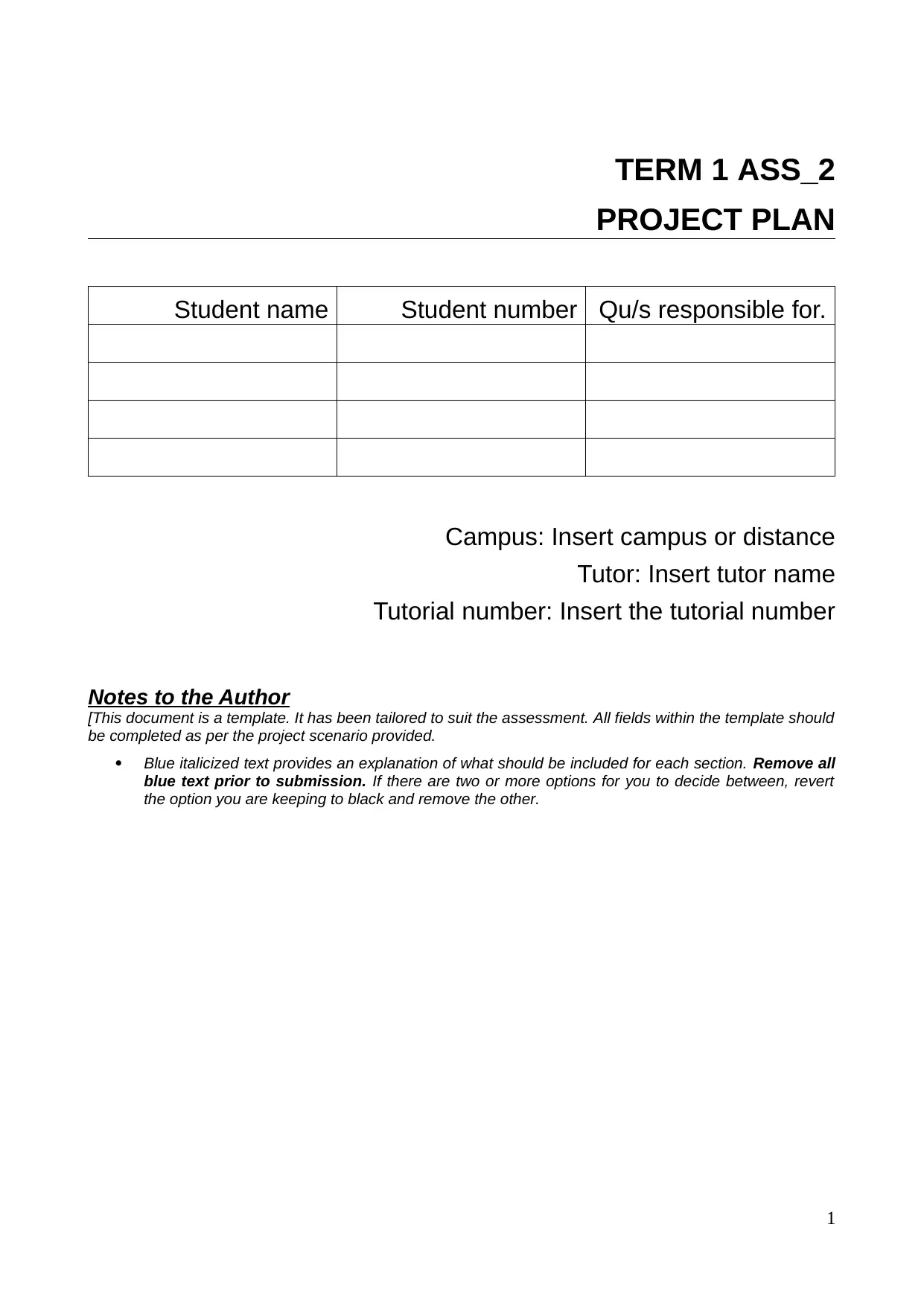
TERM 1 ASS_2
PROJECT PLAN
Student name Student number Qu/s responsible for.
Campus: Insert campus or distance
Tutor: Insert tutor name
Tutorial number: Insert the tutorial number
Notes to the Author
[This document is a template. It has been tailored to suit the assessment. All fields within the template should
be completed as per the project scenario provided.
Blue italicized text provides an explanation of what should be included for each section. Remove all
blue text prior to submission. If there are two or more options for you to decide between, revert
the option you are keeping to black and remove the other.
1
PROJECT PLAN
Student name Student number Qu/s responsible for.
Campus: Insert campus or distance
Tutor: Insert tutor name
Tutorial number: Insert the tutorial number
Notes to the Author
[This document is a template. It has been tailored to suit the assessment. All fields within the template should
be completed as per the project scenario provided.
Blue italicized text provides an explanation of what should be included for each section. Remove all
blue text prior to submission. If there are two or more options for you to decide between, revert
the option you are keeping to black and remove the other.
1
Paraphrase This Document
Need a fresh take? Get an instant paraphrase of this document with our AI Paraphraser
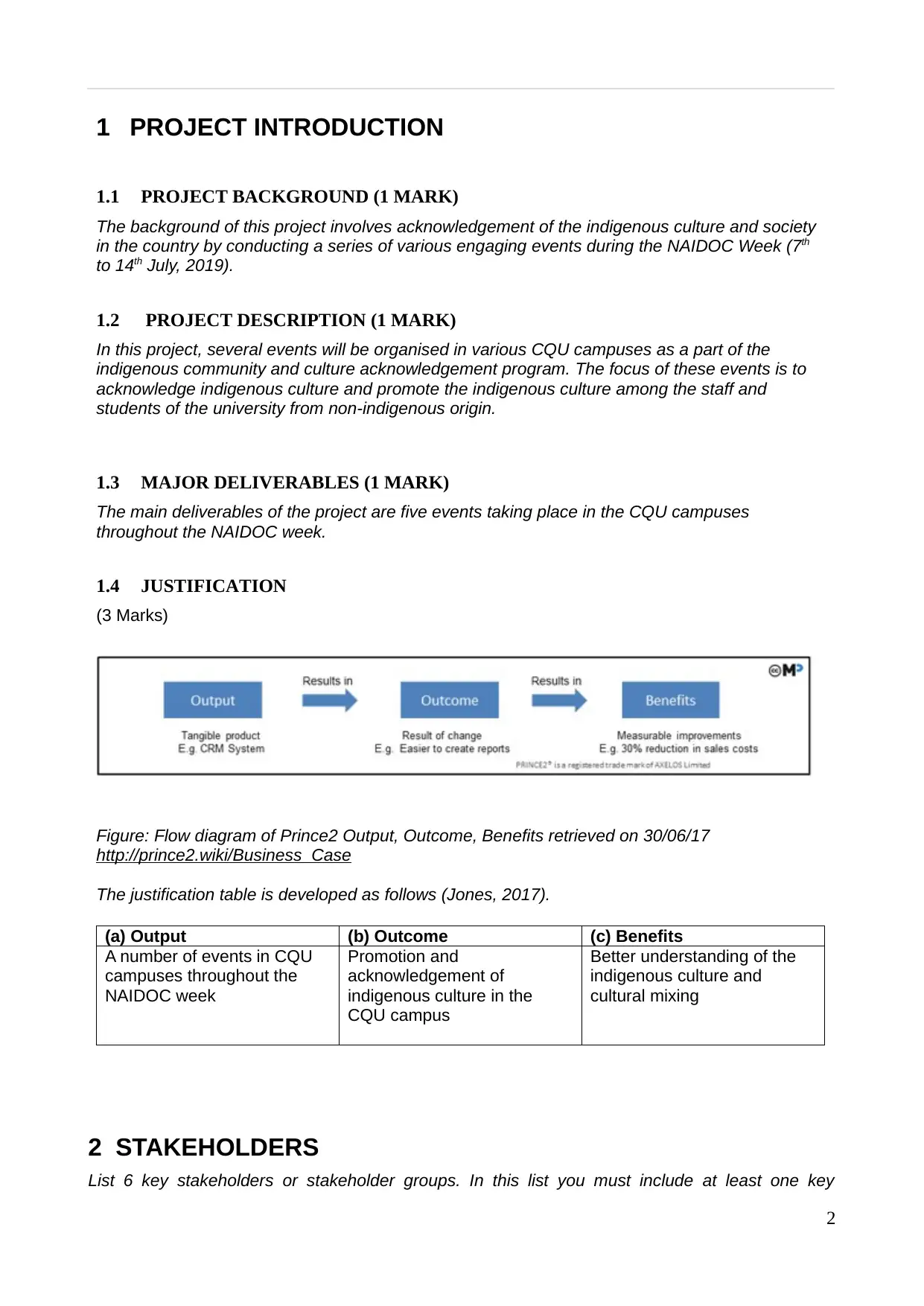
1 PROJECT INTRODUCTION
1.1 PROJECT BACKGROUND (1 MARK)
The background of this project involves acknowledgement of the indigenous culture and society
in the country by conducting a series of various engaging events during the NAIDOC Week (7th
to 14th July, 2019).
1.2 PROJECT DESCRIPTION (1 MARK)
In this project, several events will be organised in various CQU campuses as a part of the
indigenous community and culture acknowledgement program. The focus of these events is to
acknowledge indigenous culture and promote the indigenous culture among the staff and
students of the university from non-indigenous origin.
1.3 MAJOR DELIVERABLES (1 MARK)
The main deliverables of the project are five events taking place in the CQU campuses
throughout the NAIDOC week.
1.4 JUSTIFICATION
(3 Marks)
Figure: Flow diagram of Prince2 Output, Outcome, Benefits retrieved on 30/06/17
http://prince2.wiki/Business_Case
The justification table is developed as follows (Jones, 2017).
(a) Output (b) Outcome (c) Benefits
A number of events in CQU
campuses throughout the
NAIDOC week
Promotion and
acknowledgement of
indigenous culture in the
CQU campus
Better understanding of the
indigenous culture and
cultural mixing
2 STAKEHOLDERS
List 6 key stakeholders or stakeholder groups. In this list you must include at least one key
2
1.1 PROJECT BACKGROUND (1 MARK)
The background of this project involves acknowledgement of the indigenous culture and society
in the country by conducting a series of various engaging events during the NAIDOC Week (7th
to 14th July, 2019).
1.2 PROJECT DESCRIPTION (1 MARK)
In this project, several events will be organised in various CQU campuses as a part of the
indigenous community and culture acknowledgement program. The focus of these events is to
acknowledge indigenous culture and promote the indigenous culture among the staff and
students of the university from non-indigenous origin.
1.3 MAJOR DELIVERABLES (1 MARK)
The main deliverables of the project are five events taking place in the CQU campuses
throughout the NAIDOC week.
1.4 JUSTIFICATION
(3 Marks)
Figure: Flow diagram of Prince2 Output, Outcome, Benefits retrieved on 30/06/17
http://prince2.wiki/Business_Case
The justification table is developed as follows (Jones, 2017).
(a) Output (b) Outcome (c) Benefits
A number of events in CQU
campuses throughout the
NAIDOC week
Promotion and
acknowledgement of
indigenous culture in the
CQU campus
Better understanding of the
indigenous culture and
cultural mixing
2 STAKEHOLDERS
List 6 key stakeholders or stakeholder groups. In this list you must include at least one key
2

stakeholder that is a sponsor, supplier and a user. Be specific when listing whom the stakeholder
or stakeholder groups are and include the category in the second column. Do not include the
project manager as a stakeholder.
The description of interest should describe the stakeholder’s (or stakeholder groups) main interest
in the project. The description of influence should describe the potential influence the stakeholder
or stakeholder group has on the project. Complete the table below titled ‘Key stakeholder list’.
2.1 KEY STAKEHOLDER LIST
(6 Marks)
Stakeholder Category
(i.e.
Sponsor /
Supplier /
User)
Description of Interest Description of Influence
1 CQU VC Sponsor He is interest to promote
the cultural mix in the
university so that more
students come to study
He has the highest
influence of all in the project
as he is the vice chancellor
2 Event Coordinator User He is interested to show
his event coordination and
management skills
He has significant impact
on the event management
team to execute the event
as per the requirements
3 Supply Vendor Supplier The vendor is interested
to sell equipments and
other requirements for the
event and gain monetary
profit
Vendor does not have
influence on the project
except regarding the quality
of the supplies
4 Community
Development
Staff
User He / she is interested in
promoting community
development in the event.
He / she has moderate
influence on the project.
5 Indigenous
Cultural Officer
User He / she is interested in
promoting indigenous
culture among the staff
and students of CQU.
He / she has high influence
on the project.
6
Event
Management Firm
Supplier The firm is interested in
supplying workers for
management of the event
as a part of business.
The firm has no influence in
the project.
2.2 STAKEHOLDERS ENGAGEMENT ASSESSMENT MATRIX (3 MARKS)
The Project Board has asked you to complete a ‘Stakeholders Engagement Assessment Matrix’.
Please complete the matrix below for the six stakeholders previously identified. Only select one of
the engagement descriptions for each stakeholder.
Stakeholder Unaware Resistant Neutral Supportive Leading
CQU VC
Event
Coordinator
Supply
Vendor
Community
3
or stakeholder groups are and include the category in the second column. Do not include the
project manager as a stakeholder.
The description of interest should describe the stakeholder’s (or stakeholder groups) main interest
in the project. The description of influence should describe the potential influence the stakeholder
or stakeholder group has on the project. Complete the table below titled ‘Key stakeholder list’.
2.1 KEY STAKEHOLDER LIST
(6 Marks)
Stakeholder Category
(i.e.
Sponsor /
Supplier /
User)
Description of Interest Description of Influence
1 CQU VC Sponsor He is interest to promote
the cultural mix in the
university so that more
students come to study
He has the highest
influence of all in the project
as he is the vice chancellor
2 Event Coordinator User He is interested to show
his event coordination and
management skills
He has significant impact
on the event management
team to execute the event
as per the requirements
3 Supply Vendor Supplier The vendor is interested
to sell equipments and
other requirements for the
event and gain monetary
profit
Vendor does not have
influence on the project
except regarding the quality
of the supplies
4 Community
Development
Staff
User He / she is interested in
promoting community
development in the event.
He / she has moderate
influence on the project.
5 Indigenous
Cultural Officer
User He / she is interested in
promoting indigenous
culture among the staff
and students of CQU.
He / she has high influence
on the project.
6
Event
Management Firm
Supplier The firm is interested in
supplying workers for
management of the event
as a part of business.
The firm has no influence in
the project.
2.2 STAKEHOLDERS ENGAGEMENT ASSESSMENT MATRIX (3 MARKS)
The Project Board has asked you to complete a ‘Stakeholders Engagement Assessment Matrix’.
Please complete the matrix below for the six stakeholders previously identified. Only select one of
the engagement descriptions for each stakeholder.
Stakeholder Unaware Resistant Neutral Supportive Leading
CQU VC
Event
Coordinator
Supply
Vendor
Community
3
⊘ This is a preview!⊘
Do you want full access?
Subscribe today to unlock all pages.

Trusted by 1+ million students worldwide
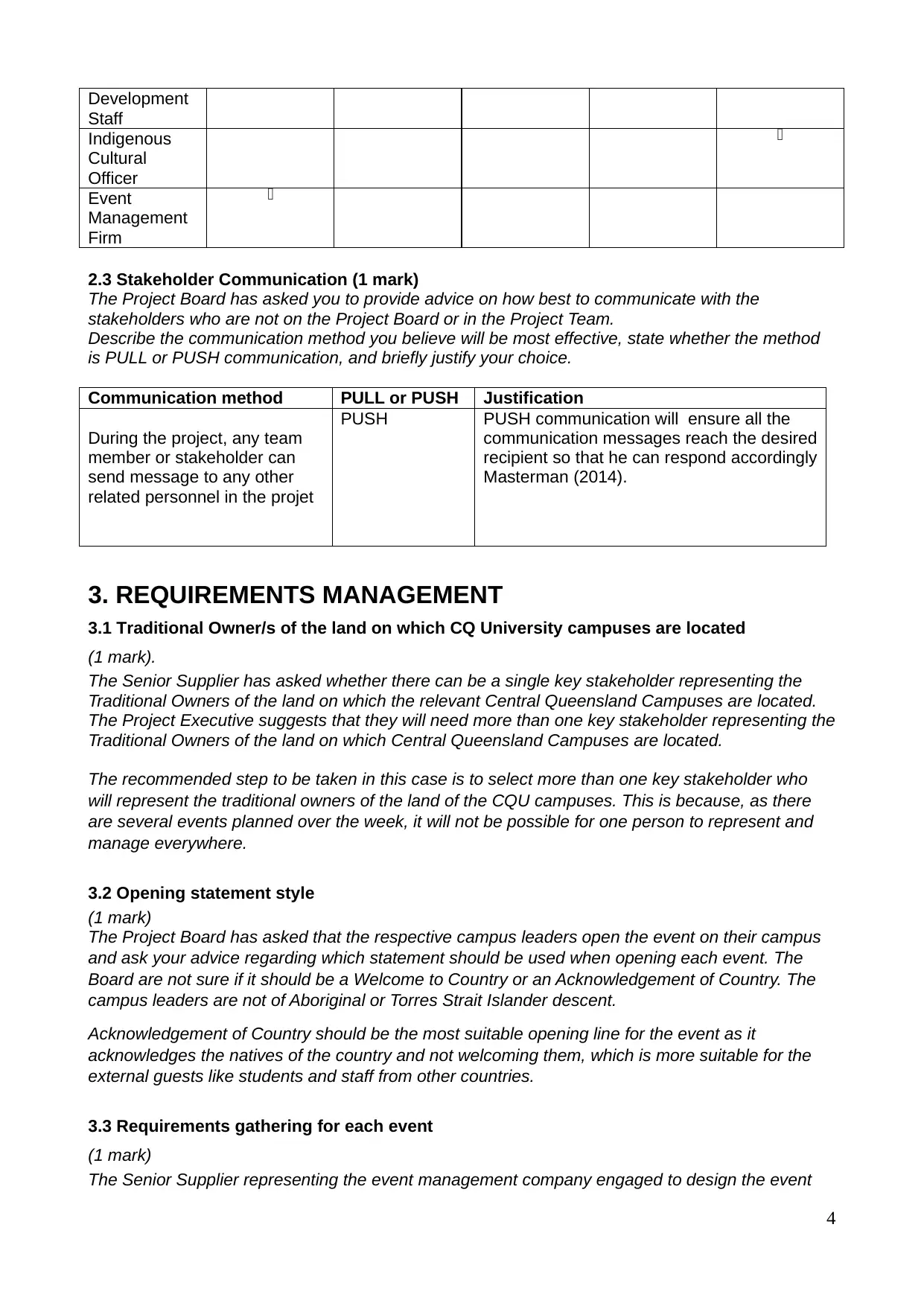
Development
Staff
Indigenous
Cultural
Officer
Event
Management
Firm
2.3 Stakeholder Communication (1 mark)
The Project Board has asked you to provide advice on how best to communicate with the
stakeholders who are not on the Project Board or in the Project Team.
Describe the communication method you believe will be most effective, state whether the method
is PULL or PUSH communication, and briefly justify your choice.
Communication method PULL or PUSH Justification
During the project, any team
member or stakeholder can
send message to any other
related personnel in the projet
PUSH PUSH communication will ensure all the
communication messages reach the desired
recipient so that he can respond accordingly
Masterman (2014).
3. REQUIREMENTS MANAGEMENT
3.1 Traditional Owner/s of the land on which CQ University campuses are located
(1 mark).
The Senior Supplier has asked whether there can be a single key stakeholder representing the
Traditional Owners of the land on which the relevant Central Queensland Campuses are located.
The Project Executive suggests that they will need more than one key stakeholder representing the
Traditional Owners of the land on which Central Queensland Campuses are located.
The recommended step to be taken in this case is to select more than one key stakeholder who
will represent the traditional owners of the land of the CQU campuses. This is because, as there
are several events planned over the week, it will not be possible for one person to represent and
manage everywhere.
3.2 Opening statement style
(1 mark)
The Project Board has asked that the respective campus leaders open the event on their campus
and ask your advice regarding which statement should be used when opening each event. The
Board are not sure if it should be a Welcome to Country or an Acknowledgement of Country. The
campus leaders are not of Aboriginal or Torres Strait Islander descent.
Acknowledgement of Country should be the most suitable opening line for the event as it
acknowledges the natives of the country and not welcoming them, which is more suitable for the
external guests like students and staff from other countries.
3.3 Requirements gathering for each event
(1 mark)
The Senior Supplier representing the event management company engaged to design the event
4
Staff
Indigenous
Cultural
Officer
Event
Management
Firm
2.3 Stakeholder Communication (1 mark)
The Project Board has asked you to provide advice on how best to communicate with the
stakeholders who are not on the Project Board or in the Project Team.
Describe the communication method you believe will be most effective, state whether the method
is PULL or PUSH communication, and briefly justify your choice.
Communication method PULL or PUSH Justification
During the project, any team
member or stakeholder can
send message to any other
related personnel in the projet
PUSH PUSH communication will ensure all the
communication messages reach the desired
recipient so that he can respond accordingly
Masterman (2014).
3. REQUIREMENTS MANAGEMENT
3.1 Traditional Owner/s of the land on which CQ University campuses are located
(1 mark).
The Senior Supplier has asked whether there can be a single key stakeholder representing the
Traditional Owners of the land on which the relevant Central Queensland Campuses are located.
The Project Executive suggests that they will need more than one key stakeholder representing the
Traditional Owners of the land on which Central Queensland Campuses are located.
The recommended step to be taken in this case is to select more than one key stakeholder who
will represent the traditional owners of the land of the CQU campuses. This is because, as there
are several events planned over the week, it will not be possible for one person to represent and
manage everywhere.
3.2 Opening statement style
(1 mark)
The Project Board has asked that the respective campus leaders open the event on their campus
and ask your advice regarding which statement should be used when opening each event. The
Board are not sure if it should be a Welcome to Country or an Acknowledgement of Country. The
campus leaders are not of Aboriginal or Torres Strait Islander descent.
Acknowledgement of Country should be the most suitable opening line for the event as it
acknowledges the natives of the country and not welcoming them, which is more suitable for the
external guests like students and staff from other countries.
3.3 Requirements gathering for each event
(1 mark)
The Senior Supplier representing the event management company engaged to design the event
4
Paraphrase This Document
Need a fresh take? Get an instant paraphrase of this document with our AI Paraphraser
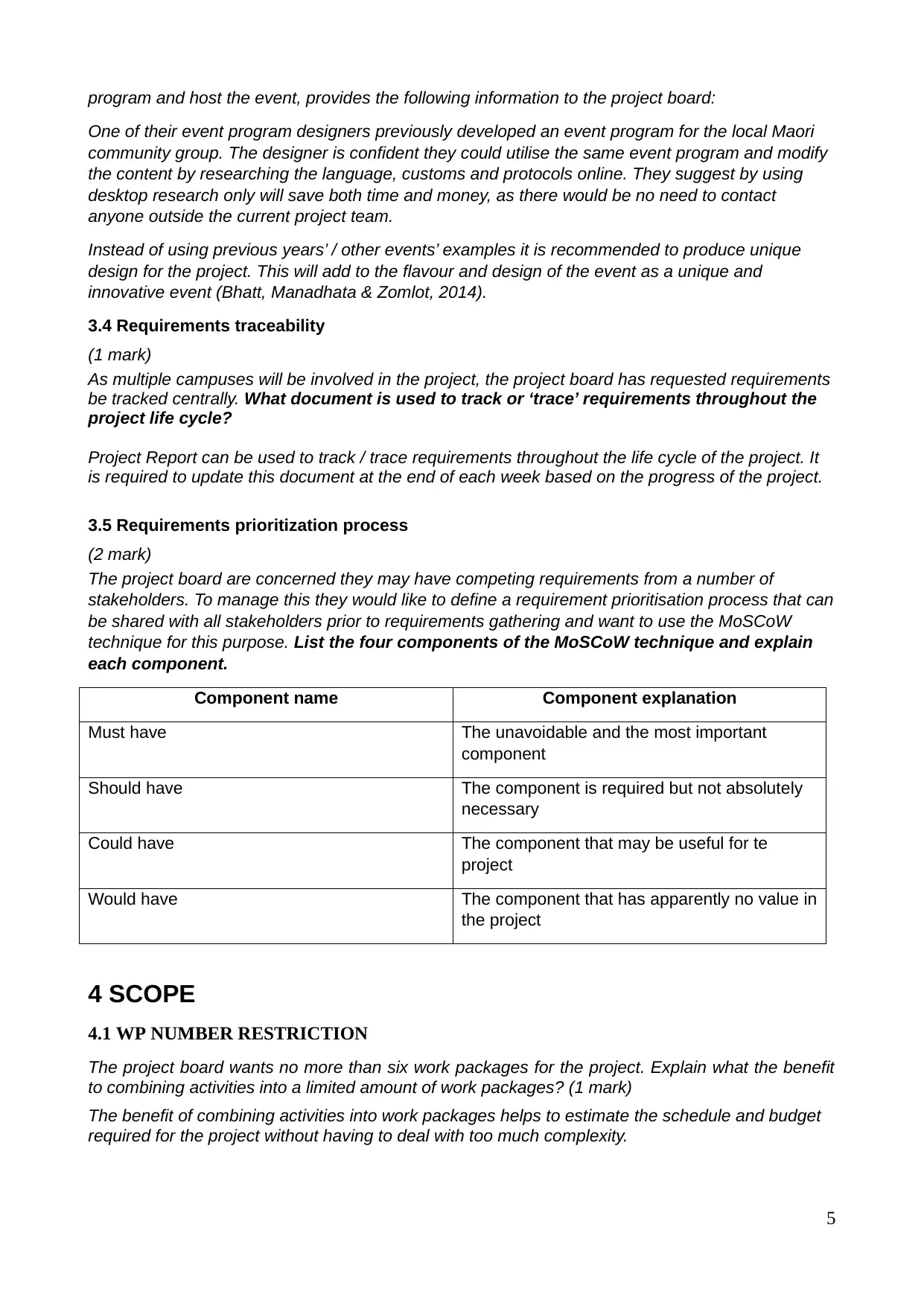
program and host the event, provides the following information to the project board:
One of their event program designers previously developed an event program for the local Maori
community group. The designer is confident they could utilise the same event program and modify
the content by researching the language, customs and protocols online. They suggest by using
desktop research only will save both time and money, as there would be no need to contact
anyone outside the current project team.
Instead of using previous years’ / other events’ examples it is recommended to produce unique
design for the project. This will add to the flavour and design of the event as a unique and
innovative event (Bhatt, Manadhata & Zomlot, 2014).
3.4 Requirements traceability
(1 mark)
As multiple campuses will be involved in the project, the project board has requested requirements
be tracked centrally. What document is used to track or ‘trace’ requirements throughout the
project life cycle?
Project Report can be used to track / trace requirements throughout the life cycle of the project. It
is required to update this document at the end of each week based on the progress of the project.
3.5 Requirements prioritization process
(2 mark)
The project board are concerned they may have competing requirements from a number of
stakeholders. To manage this they would like to define a requirement prioritisation process that can
be shared with all stakeholders prior to requirements gathering and want to use the MoSCoW
technique for this purpose. List the four components of the MoSCoW technique and explain
each component.
Component name Component explanation
Must have The unavoidable and the most important
component
Should have The component is required but not absolutely
necessary
Could have The component that may be useful for te
project
Would have The component that has apparently no value in
the project
4 SCOPE
4.1 WP NUMBER RESTRICTION
The project board wants no more than six work packages for the project. Explain what the benefit
to combining activities into a limited amount of work packages? (1 mark)
The benefit of combining activities into work packages helps to estimate the schedule and budget
required for the project without having to deal with too much complexity.
5
One of their event program designers previously developed an event program for the local Maori
community group. The designer is confident they could utilise the same event program and modify
the content by researching the language, customs and protocols online. They suggest by using
desktop research only will save both time and money, as there would be no need to contact
anyone outside the current project team.
Instead of using previous years’ / other events’ examples it is recommended to produce unique
design for the project. This will add to the flavour and design of the event as a unique and
innovative event (Bhatt, Manadhata & Zomlot, 2014).
3.4 Requirements traceability
(1 mark)
As multiple campuses will be involved in the project, the project board has requested requirements
be tracked centrally. What document is used to track or ‘trace’ requirements throughout the
project life cycle?
Project Report can be used to track / trace requirements throughout the life cycle of the project. It
is required to update this document at the end of each week based on the progress of the project.
3.5 Requirements prioritization process
(2 mark)
The project board are concerned they may have competing requirements from a number of
stakeholders. To manage this they would like to define a requirement prioritisation process that can
be shared with all stakeholders prior to requirements gathering and want to use the MoSCoW
technique for this purpose. List the four components of the MoSCoW technique and explain
each component.
Component name Component explanation
Must have The unavoidable and the most important
component
Should have The component is required but not absolutely
necessary
Could have The component that may be useful for te
project
Would have The component that has apparently no value in
the project
4 SCOPE
4.1 WP NUMBER RESTRICTION
The project board wants no more than six work packages for the project. Explain what the benefit
to combining activities into a limited amount of work packages? (1 mark)
The benefit of combining activities into work packages helps to estimate the schedule and budget
required for the project without having to deal with too much complexity.
5

4.2 WORK BREAKDOWN DIAGRAM
Complete the WBS below. It must comprise 3 levels and 6 work packages. Please note: The third
level comprises work packages. You need to insert a name and id in each of these work packages.
(4 marks)
Note: This WBS is intended to represent the full project scope of the project.
6
1. Indigenous Culture
Based Events in NAIDOC
Week
1.3 Execution1.2 Preparations1.1 Planning
1.3.2 Execution
of All Event
Activities
1.3.1 Manage
the Events
1.2.2 Set Up
Event Venues
1.2.1 Make
Arrangements
for the events
1.1.2
Requirement
Analysis and
Project
Planning
1.1.1
Requirement
Gathering
Complete the WBS below. It must comprise 3 levels and 6 work packages. Please note: The third
level comprises work packages. You need to insert a name and id in each of these work packages.
(4 marks)
Note: This WBS is intended to represent the full project scope of the project.
6
1. Indigenous Culture
Based Events in NAIDOC
Week
1.3 Execution1.2 Preparations1.1 Planning
1.3.2 Execution
of All Event
Activities
1.3.1 Manage
the Events
1.2.2 Set Up
Event Venues
1.2.1 Make
Arrangements
for the events
1.1.2
Requirement
Analysis and
Project
Planning
1.1.1
Requirement
Gathering
⊘ This is a preview!⊘
Do you want full access?
Subscribe today to unlock all pages.

Trusted by 1+ million students worldwide

4.3 WBS DICTIONARY
(6 Marks)
Complete the WBS dictionary below. The dictionary describes each element in the WBS diagram.
In this assessment you are required to complete a table for each work package within your WBS.
There is 1 mark allocated for each of the six work packages listed.
Note: This WBS is intended to represent the full project scope of the project.
1.1.1 Requirement Gathering
Description of work Defining the exact requirements and specifications for the
event
Cost Estimate
Start and Finish Dates
1.1.2 Requirement Analysis and Project Planning
Description of work Analysis of event requirements and development of
project plan
Cost Estimate
Start and Finish Dates
1.2.1 Make Arrangements for the events
Description of work Procure resources and deploy manpower for setting up
the event
Cost Estimate
Start and Finish Dates
1.2.2 Set Up Event Venues
Description of work Select the venues in which the events will be hosted
Cost Estimate
Start and Finish Dates
7
(6 Marks)
Complete the WBS dictionary below. The dictionary describes each element in the WBS diagram.
In this assessment you are required to complete a table for each work package within your WBS.
There is 1 mark allocated for each of the six work packages listed.
Note: This WBS is intended to represent the full project scope of the project.
1.1.1 Requirement Gathering
Description of work Defining the exact requirements and specifications for the
event
Cost Estimate
Start and Finish Dates
1.1.2 Requirement Analysis and Project Planning
Description of work Analysis of event requirements and development of
project plan
Cost Estimate
Start and Finish Dates
1.2.1 Make Arrangements for the events
Description of work Procure resources and deploy manpower for setting up
the event
Cost Estimate
Start and Finish Dates
1.2.2 Set Up Event Venues
Description of work Select the venues in which the events will be hosted
Cost Estimate
Start and Finish Dates
7
Paraphrase This Document
Need a fresh take? Get an instant paraphrase of this document with our AI Paraphraser

1.3.1 Manage the Events
Description of work Final preparations and management of the events
Cost Estimate
Start and Finish Dates
1.3.2 Execution of All Event Activities
Description of work Execution of specified activities in the events as per
requirements
Cost Estimate
Start and Finish Dates
8
Description of work Final preparations and management of the events
Cost Estimate
Start and Finish Dates
1.3.2 Execution of All Event Activities
Description of work Execution of specified activities in the events as per
requirements
Cost Estimate
Start and Finish Dates
8

5 SCHEDULE (6 MARKS)
The project executive has asked that the project work be completed in time for NAIDOC
week this year. However, project work cannot be started earlier than 14 May. You must
include the work package name and id
In the tables that follow, list at least two (2) work activities for each of the six (6) work
packages selected. Also include the start and end dates and duration in days for each
activity.
1.1.1 Requirement Gathering
Activity Description of work Start
Date
End
Date
Duration
(days)
Conduct meeting Team meeting for discussion of the event 14th
May
16th
Ma
y
3
Discuss details and
requirements
Discussion between stakeholders 14th
May
16th
Ma
y
3
Finalise event details Finalise the details 15th
May
16th
Ma
y
1
1.1.2 Requirement Analysis and Project Planning
Activity Description of work Start
Date
End
Date
Duration
(days)
Receive detailed
requirements for the
event
Receive project brief 17th
May
18th
Ma
y
1
Analysis of
requirements
Analyse the project brief 19th
May
22nd
Ma
y
4
Development of
project plan
Develop project plan as per the
requirements
23rd
May
10th
Jun
e
19
1.2.1 Make Arrangements for the events
Activity Description of work Start
Date
End
Date
Duration
(days)
Develop list of
resources
Determine resources required for the
events
11th
June
14th
Jun
e
4
Purchase resources
required
Purchase the resources 15th
June
18th
Jun
e
4
Make appropriate
arrangements
Develop resource usage plan 19th
June
23rd
Jun
e
5
1.2.2 Set Up Event Venues
Activity Description of work Start
Date
End
Date
Duration
(days)
Develop a list of all Required for selection of appropriate 23rd 28th 6
9
The project executive has asked that the project work be completed in time for NAIDOC
week this year. However, project work cannot be started earlier than 14 May. You must
include the work package name and id
In the tables that follow, list at least two (2) work activities for each of the six (6) work
packages selected. Also include the start and end dates and duration in days for each
activity.
1.1.1 Requirement Gathering
Activity Description of work Start
Date
End
Date
Duration
(days)
Conduct meeting Team meeting for discussion of the event 14th
May
16th
Ma
y
3
Discuss details and
requirements
Discussion between stakeholders 14th
May
16th
Ma
y
3
Finalise event details Finalise the details 15th
May
16th
Ma
y
1
1.1.2 Requirement Analysis and Project Planning
Activity Description of work Start
Date
End
Date
Duration
(days)
Receive detailed
requirements for the
event
Receive project brief 17th
May
18th
Ma
y
1
Analysis of
requirements
Analyse the project brief 19th
May
22nd
Ma
y
4
Development of
project plan
Develop project plan as per the
requirements
23rd
May
10th
Jun
e
19
1.2.1 Make Arrangements for the events
Activity Description of work Start
Date
End
Date
Duration
(days)
Develop list of
resources
Determine resources required for the
events
11th
June
14th
Jun
e
4
Purchase resources
required
Purchase the resources 15th
June
18th
Jun
e
4
Make appropriate
arrangements
Develop resource usage plan 19th
June
23rd
Jun
e
5
1.2.2 Set Up Event Venues
Activity Description of work Start
Date
End
Date
Duration
(days)
Develop a list of all Required for selection of appropriate 23rd 28th 6
9
⊘ This is a preview!⊘
Do you want full access?
Subscribe today to unlock all pages.

Trusted by 1+ million students worldwide
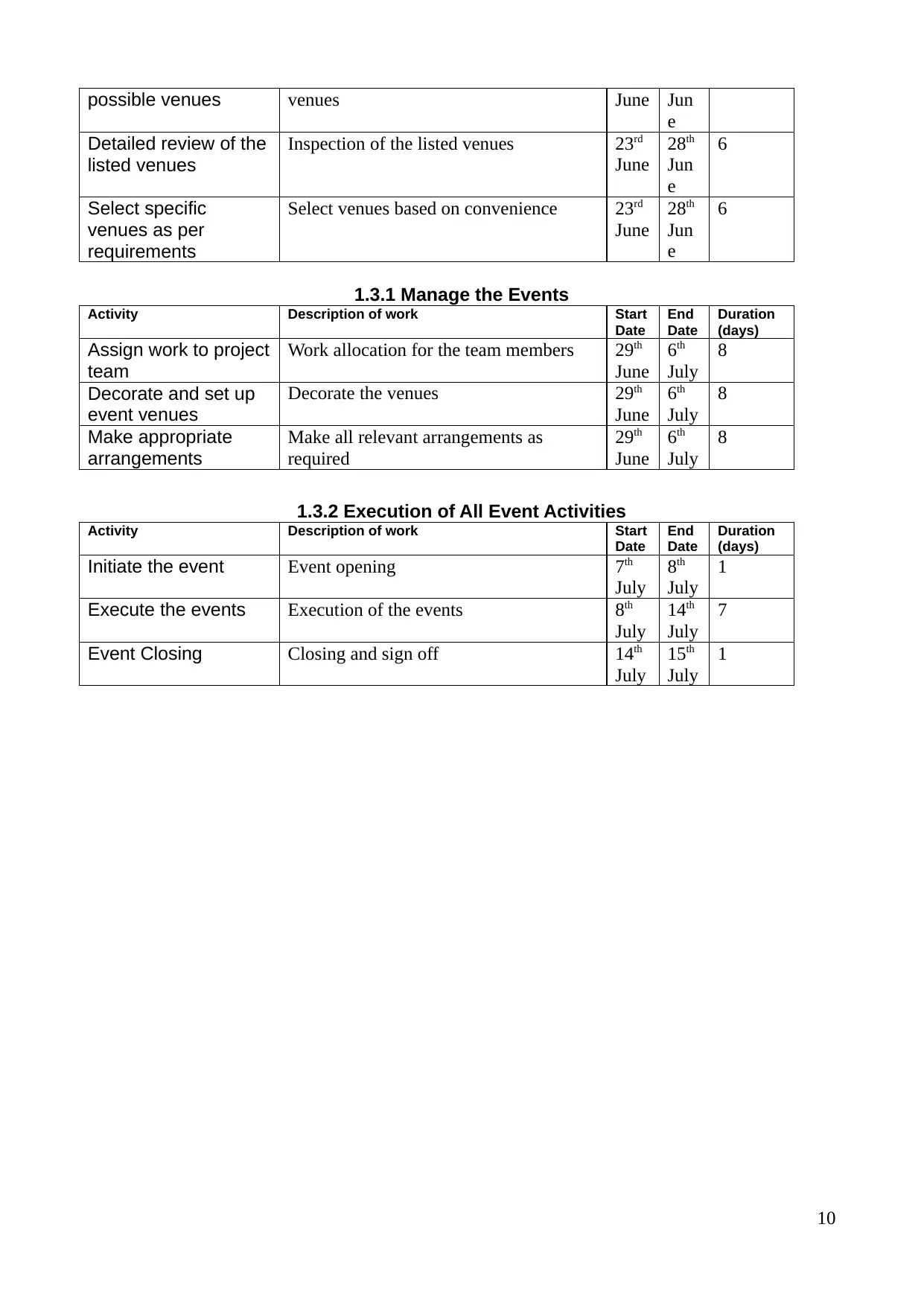
possible venues venues June Jun
e
Detailed review of the
listed venues
Inspection of the listed venues 23rd
June
28th
Jun
e
6
Select specific
venues as per
requirements
Select venues based on convenience 23rd
June
28th
Jun
e
6
1.3.1 Manage the Events
Activity Description of work Start
Date
End
Date
Duration
(days)
Assign work to project
team
Work allocation for the team members 29th
June
6th
July
8
Decorate and set up
event venues
Decorate the venues 29th
June
6th
July
8
Make appropriate
arrangements
Make all relevant arrangements as
required
29th
June
6th
July
8
1.3.2 Execution of All Event Activities
Activity Description of work Start
Date
End
Date
Duration
(days)
Initiate the event Event opening 7th
July
8th
July
1
Execute the events Execution of the events 8th
July
14th
July
7
Event Closing Closing and sign off 14th
July
15th
July
1
10
e
Detailed review of the
listed venues
Inspection of the listed venues 23rd
June
28th
Jun
e
6
Select specific
venues as per
requirements
Select venues based on convenience 23rd
June
28th
Jun
e
6
1.3.1 Manage the Events
Activity Description of work Start
Date
End
Date
Duration
(days)
Assign work to project
team
Work allocation for the team members 29th
June
6th
July
8
Decorate and set up
event venues
Decorate the venues 29th
June
6th
July
8
Make appropriate
arrangements
Make all relevant arrangements as
required
29th
June
6th
July
8
1.3.2 Execution of All Event Activities
Activity Description of work Start
Date
End
Date
Duration
(days)
Initiate the event Event opening 7th
July
8th
July
1
Execute the events Execution of the events 8th
July
14th
July
7
Event Closing Closing and sign off 14th
July
15th
July
1
10
Paraphrase This Document
Need a fresh take? Get an instant paraphrase of this document with our AI Paraphraser
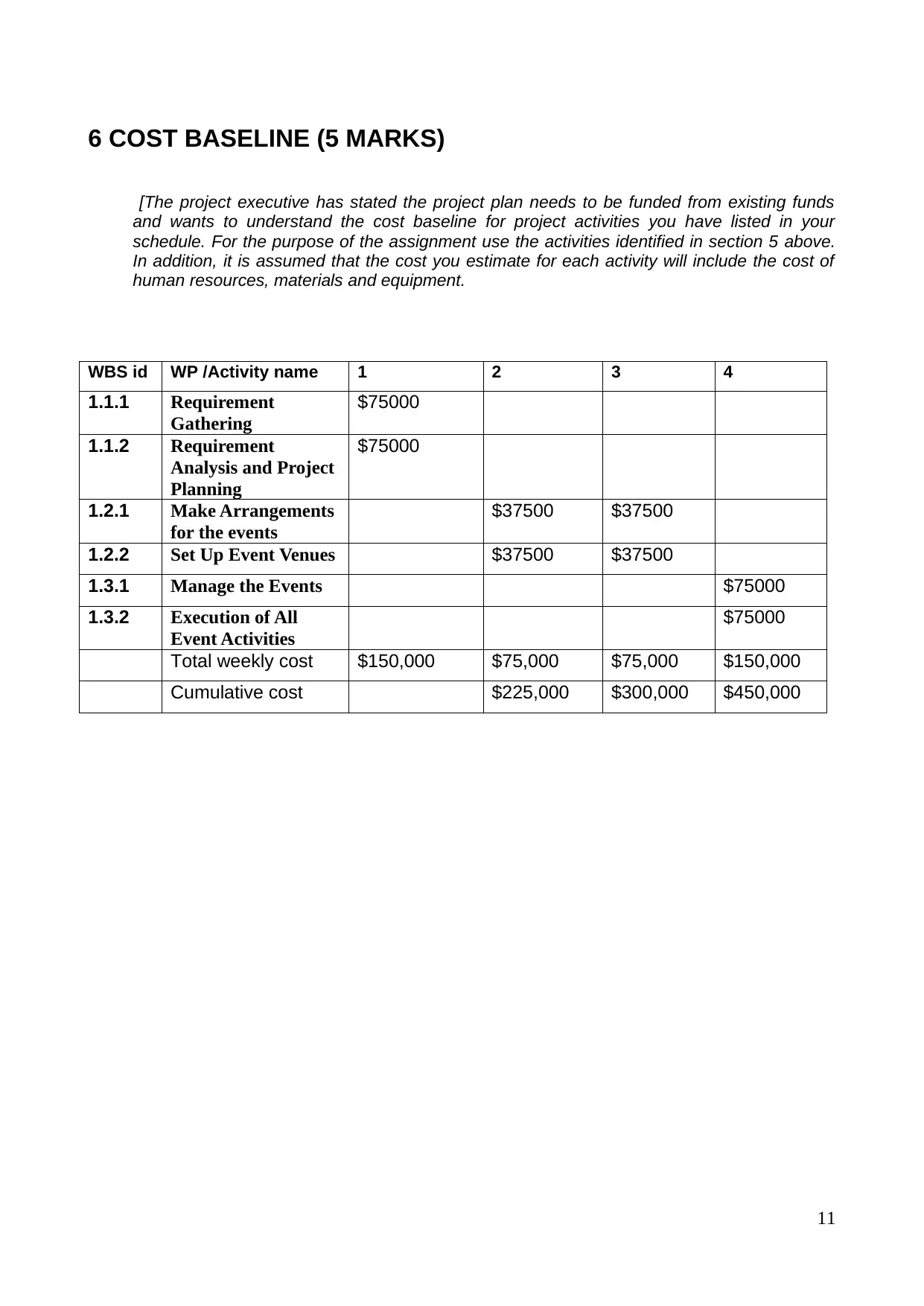
6 COST BASELINE (5 MARKS)
[The project executive has stated the project plan needs to be funded from existing funds
and wants to understand the cost baseline for project activities you have listed in your
schedule. For the purpose of the assignment use the activities identified in section 5 above.
In addition, it is assumed that the cost you estimate for each activity will include the cost of
human resources, materials and equipment.
WBS id WP /Activity name 1 2 3 4
1.1.1 Requirement
Gathering
$75000
1.1.2 Requirement
Analysis and Project
Planning
$75000
1.2.1 Make Arrangements
for the events
$37500 $37500
1.2.2 Set Up Event Venues $37500 $37500
1.3.1 Manage the Events $75000
1.3.2 Execution of All
Event Activities
$75000
Total weekly cost $150,000 $75,000 $75,000 $150,000
Cumulative cost $225,000 $300,000 $450,000
11
[The project executive has stated the project plan needs to be funded from existing funds
and wants to understand the cost baseline for project activities you have listed in your
schedule. For the purpose of the assignment use the activities identified in section 5 above.
In addition, it is assumed that the cost you estimate for each activity will include the cost of
human resources, materials and equipment.
WBS id WP /Activity name 1 2 3 4
1.1.1 Requirement
Gathering
$75000
1.1.2 Requirement
Analysis and Project
Planning
$75000
1.2.1 Make Arrangements
for the events
$37500 $37500
1.2.2 Set Up Event Venues $37500 $37500
1.3.1 Manage the Events $75000
1.3.2 Execution of All
Event Activities
$75000
Total weekly cost $150,000 $75,000 $75,000 $150,000
Cumulative cost $225,000 $300,000 $450,000
11
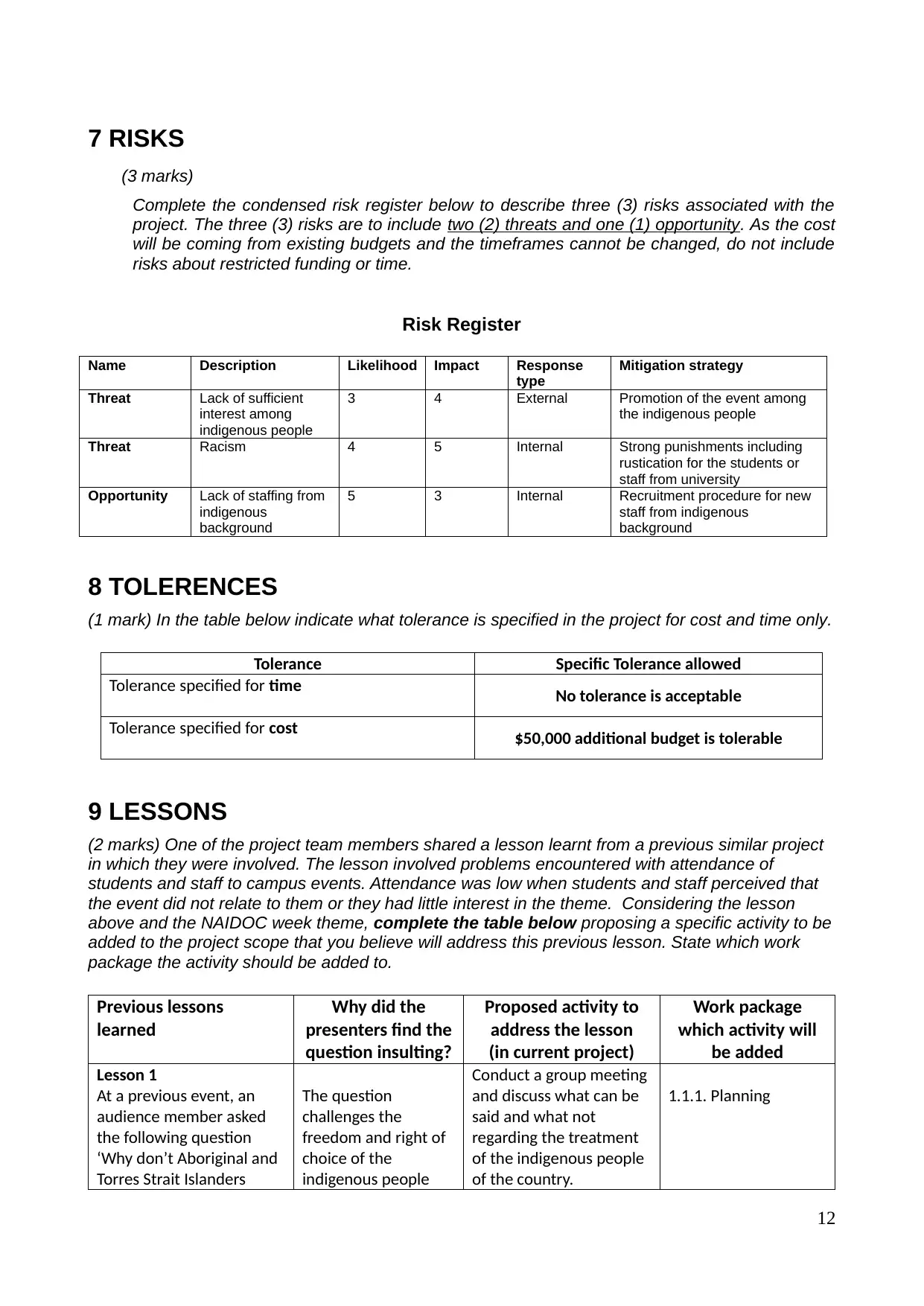
7 RISKS
(3 marks)
Complete the condensed risk register below to describe three (3) risks associated with the
project. The three (3) risks are to include two (2) threats and one (1) opportunity. As the cost
will be coming from existing budgets and the timeframes cannot be changed, do not include
risks about restricted funding or time.
Risk Register
Name Description Likelihood Impact Response
type
Mitigation strategy
Threat Lack of sufficient
interest among
indigenous people
3 4 External Promotion of the event among
the indigenous people
Threat Racism 4 5 Internal Strong punishments including
rustication for the students or
staff from university
Opportunity Lack of staffing from
indigenous
background
5 3 Internal Recruitment procedure for new
staff from indigenous
background
8 TOLERENCES
(1 mark) In the table below indicate what tolerance is specified in the project for cost and time only.
Tolerance Specific Tolerance allowed
Tolerance specified for time No tolerance is acceptable
Tolerance specified for cost $50,000 additional budget is tolerable
9 LESSONS
(2 marks) One of the project team members shared a lesson learnt from a previous similar project
in which they were involved. The lesson involved problems encountered with attendance of
students and staff to campus events. Attendance was low when students and staff perceived that
the event did not relate to them or they had little interest in the theme. Considering the lesson
above and the NAIDOC week theme, complete the table below proposing a specific activity to be
added to the project scope that you believe will address this previous lesson. State which work
package the activity should be added to.
Previous lessons
learned
Why did the
presenters find the
question insulting?
Proposed activity to
address the lesson
(in current project)
Work package
which activity will
be added
Lesson 1
At a previous event, an
audience member asked
the following question
‘Why don’t Aboriginal and
Torres Strait Islanders
The question
challenges the
freedom and right of
choice of the
indigenous people
Conduct a group meeting
and discuss what can be
said and what not
regarding the treatment
of the indigenous people
of the country.
1.1.1. Planning
12
(3 marks)
Complete the condensed risk register below to describe three (3) risks associated with the
project. The three (3) risks are to include two (2) threats and one (1) opportunity. As the cost
will be coming from existing budgets and the timeframes cannot be changed, do not include
risks about restricted funding or time.
Risk Register
Name Description Likelihood Impact Response
type
Mitigation strategy
Threat Lack of sufficient
interest among
indigenous people
3 4 External Promotion of the event among
the indigenous people
Threat Racism 4 5 Internal Strong punishments including
rustication for the students or
staff from university
Opportunity Lack of staffing from
indigenous
background
5 3 Internal Recruitment procedure for new
staff from indigenous
background
8 TOLERENCES
(1 mark) In the table below indicate what tolerance is specified in the project for cost and time only.
Tolerance Specific Tolerance allowed
Tolerance specified for time No tolerance is acceptable
Tolerance specified for cost $50,000 additional budget is tolerable
9 LESSONS
(2 marks) One of the project team members shared a lesson learnt from a previous similar project
in which they were involved. The lesson involved problems encountered with attendance of
students and staff to campus events. Attendance was low when students and staff perceived that
the event did not relate to them or they had little interest in the theme. Considering the lesson
above and the NAIDOC week theme, complete the table below proposing a specific activity to be
added to the project scope that you believe will address this previous lesson. State which work
package the activity should be added to.
Previous lessons
learned
Why did the
presenters find the
question insulting?
Proposed activity to
address the lesson
(in current project)
Work package
which activity will
be added
Lesson 1
At a previous event, an
audience member asked
the following question
‘Why don’t Aboriginal and
Torres Strait Islanders
The question
challenges the
freedom and right of
choice of the
indigenous people
Conduct a group meeting
and discuss what can be
said and what not
regarding the treatment
of the indigenous people
of the country.
1.1.1. Planning
12
⊘ This is a preview!⊘
Do you want full access?
Subscribe today to unlock all pages.

Trusted by 1+ million students worldwide
1 out of 13
Related Documents
Your All-in-One AI-Powered Toolkit for Academic Success.
+13062052269
info@desklib.com
Available 24*7 on WhatsApp / Email
![[object Object]](/_next/static/media/star-bottom.7253800d.svg)
Unlock your academic potential
Copyright © 2020–2025 A2Z Services. All Rights Reserved. Developed and managed by ZUCOL.




